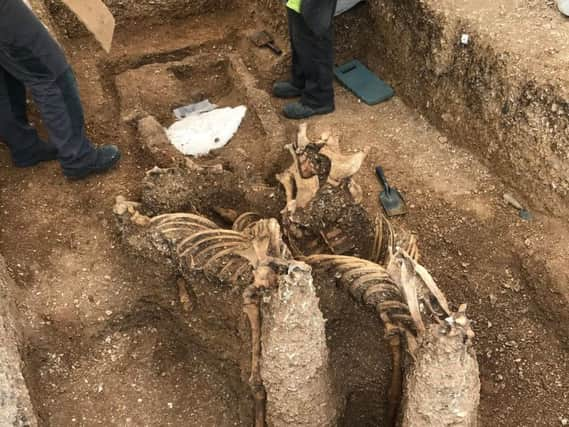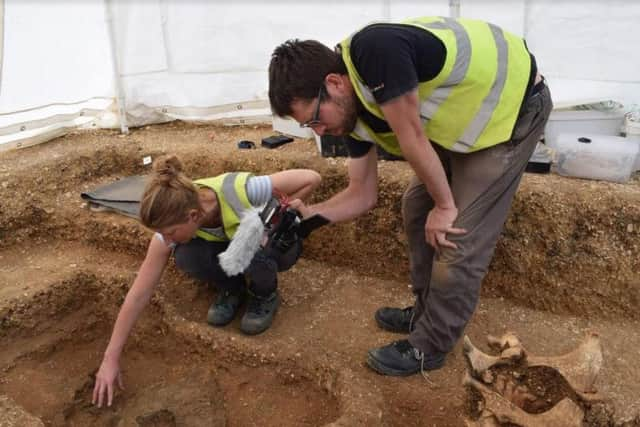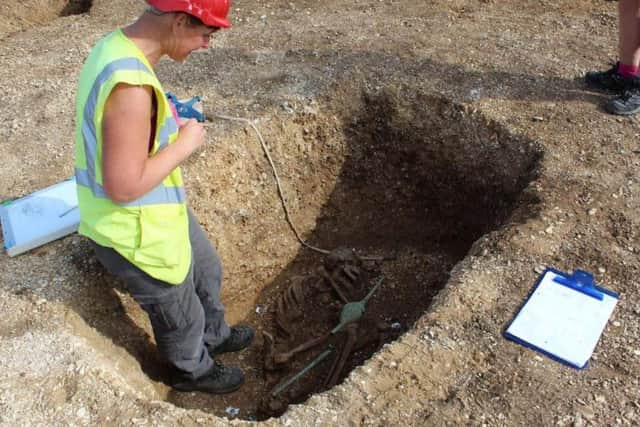Iron Age chariot burial found in East Yorkshire with horses 'leaping out of the grave'


The pair had been carefully positioned in the Iron Age grave at Pocklington with their back legs bent and hooves just off the ground - ready to spring into the next life.
The chariot - with a man aged in his late 40 upwards in a fetal position inside - had also been buried upright, as though the vehicle was ready to roll on "into any future life."
Advertisement
Hide AdAdvertisement
Hide AdArchaeologists say the horses may have originally been buried with their heads sticking out of the grave, although when found they were headless.


More details have emerged about the finds at the Persimmon Homes building site at The Mile ahead of a BBC programme later this month.
It comes just a year after another Iron Age chariot and two well-preserved horses were discovered on another building site in the town, David Wilson Homes’ Pavilion Square development.
The horses were buried with a "highly regarded member of the community" who was in his late 40s or older, whose head was surrounded by the bones of six piglets, believed to be an offering, along with a well-preserved shield and a highly decorative brooch.
Advertisement
Hide AdAdvertisement
Hide AdEast Yorkshire is known for its chariot burials but Paula Ware from MAP Archaeological Practice said the type of burial rite had “no British parallel."


She said: "We couldn't tell how they were placed in the grave. Both were still upright and they were placed as though in motion as if they were leaping out of the grave. It looked as though their skulls were removed centuries ago.
"Possibly the heads were coming out of the graves. Did they go in alive who knows? There's no evidence of a ramp.
"This is a new burial rite which has never been seen before. How spectacular this is - and what time and effort must have gone into it and the people who must have taken part in this burial process, digging this 4.7m by 3.9m grave.
Advertisement
Hide AdAdvertisement
Hide Ad"There is more pig bone in this burial than there has been seen in burials across the Wolds.
"He is honoured with at least six piglets - normally there would be a quarter of a jaw. He was someone so significant."
Nearby was another amazing find - a young man aged 17 to 25 - who had been "ritually speared" with 10 iron and bone spears. He had suffered blunt force trauma indicative of being in a conflict.
It has been suggested by other experts following similar discoveries that it could be a Dracula-like ritual to ensure the corpse remained dead.
Advertisement
Hide AdAdvertisement
Hide AdBut Ms Ware believes it was to release the youngster's spirit, and was a sign of respect from the community.
Ms Ware said: "We will never know because there was no written word and we can only speculate."
Simon Usher, managing director at Persimmon Homes Yorkshire, said: “Everyone has been absolutely thrilled by the finds.
"Keeping the news under wraps while the excavation was completed has been a real challenge, but so important to ensure the integrity of the site.”
Advertisement
Hide AdAdvertisement
Hide AdThe developers are planning to donate the discovery to a museum. The exact beneficiary is to be confirmed, but the housebuilder would like the find to remain in the local area.
The discovery will be broadcast on the BBC's Digging for Britain, at 9pm on Wednesday December 19 on BBC Four.